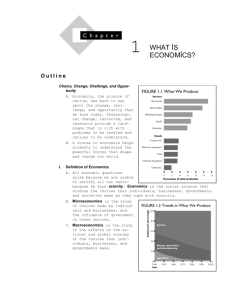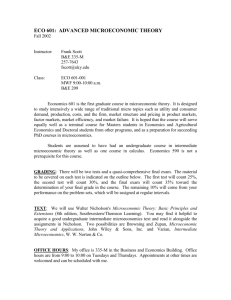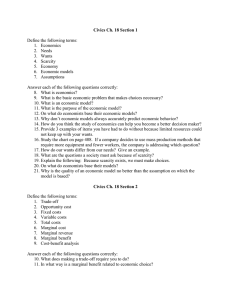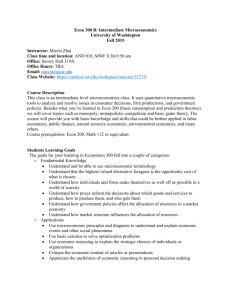Choice, Change, Challenge, and Opportunity
advertisement
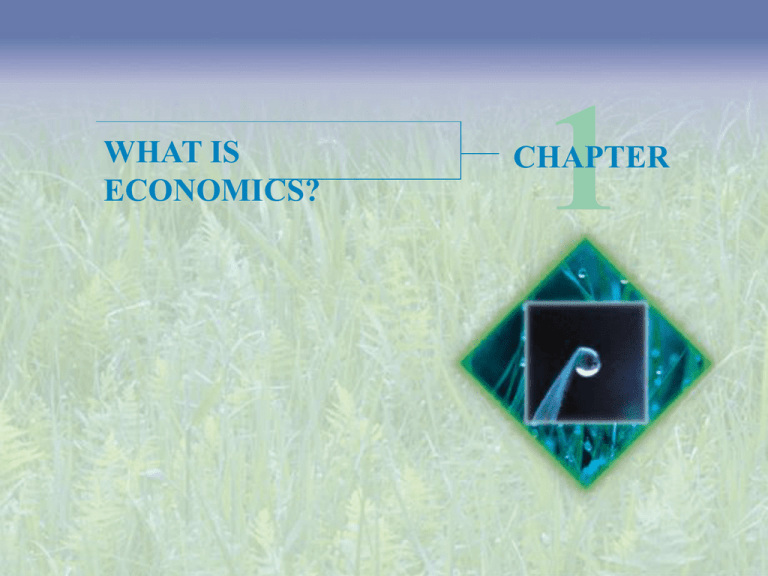
WHAT IS ECONOMICS? 1 CHAPTER Objectives After studying this chapter, you will be able to: Define economics and distinguish between microeconomics and macroeconomics Explain the three big questions of microeconomics Explain the three big questions of macroeconomics Explain the ideas that define the economic way of thinking Explain how economists go about their work as social scientists Choice, Change, Challenge, and Opportunity Economics, the science of choice, has much to say about the change, challenge, and opportunity that we face today. Technological change, terrorism, and recession provide a landscape that is rich with problems to be tackled and choices to be understood. Your economics course helps you to understand the powerful forces that shape and change our world. Definition of Economics Scarcity All economic questions arise because we are unable to satisfy all our wants—because we face scarcity. Economics is the social science that studies the choices that individuals, businesses, governments, and societies make as they cope with scarcity. Definition of Economics Microeconomics Microeconomics is the study of choices made by individuals and businesses, and the influence of government on those choices. Macroeconomics Macroeconomics is the study of the effects on the national and global economy of the choices that individuals, businesses, and governments make. Three Big Microeconomic Questions Microeconomics seeks to understand what determines: What goods and services are produced How goods and services are produced For whom goods and services are produced Goods and services are the objects that people value and produce to satisfy wants. Three Big Microeconomic Questions What Goods and Services are Produced? Figure 1.1 shows the major items produced in the U.S. economy today. It emphasizes the dominant place of services in our economy. Three Big Microeconomic Questions Figure 1.2 shows the trends in what the U.S. economy has produced over the past 60 years. It shows the decline of agriculture, mining, construction, and manufacturing, and the expansion of services. Three Big Microeconomic Questions The facts about what we produce raise the deeper question: What determines the quantities of realtor services, new homes, DVD players, and corn that we produce? Microeconomics provides some answers to these questions. Three Big Microeconomic Questions How are Goods and Services Produced? Factors of production are the resources that businesses use to produce goods and services. They are grouped into four categories: Land Labor Capital Entrepreneurship Three Big Microeconomic Questions The “gifts of nature” that we use to produce goods and services are land. The work time and effort that people devote to producing goods and services is labor. The quality of labor depends on human capital, which is the knowledge and skill that people obtain from education, on-the-job training, and work experience. Three Big Microeconomic Questions The tools, instruments, machines, buildings, and other constructions that are used to produce goods and services are capital. The human resource that organizes land, labor, and capital is entrepreneurship. Three Big Microeconomic Questions Figure 1.3 shows a measure of the growth of human capital in the United States over the last century—the percentage of the population that has completed different levels of education. Three Big Microeconomic Questions The facts about how we produce raise the deeper question: What determines the quantities of capital, labor, and other resources that get used to produce goods and services? Microeconomics provides some answers to this question. Three Big Microeconomic Questions For Whom are Goods and Services Produced? Who gets the goods and services depends on the incomes that people earn. Land earns rent. Labor earns wages. Capital earns interest. Entrepreneurship earns profit. Three Big Microeconomic Questions Figure 1.4 shows the distribution of income in the United States. The richest 20 percent earn almost 50 percent of total income while the poorest 20 percent earn only 4 percent of total income. Three Big Microeconomic Questions The facts about for whom raise the deeper question: What determines earnings and the distribution of income that in turn determine who gets the goods and services produced? Microeconomics provides some answers to this question. Three Big Macroeconomic Questions Macroeconomics focuses on three big questions: What determines the standard of living? What determines the cost of living? Why does our economy fluctuate? Three Big Macroeconomic Questions What Determines the Standard of Living? The standard of living is the level of consumption that people enjoy on the average and is measured by average income per person. Three Big Macroeconomic Questions Figure 1.5 shows income per person per day in a number of countries and regions. The United States has one of the highest standards of living, and the nations of Africa have the lowest. Three Big Macroeconomic Questions Macroeconomics seeks to explain differences in the standard of living across countries. Macroeconomics also seeks to explain the rate at which the standard of living changes. Three Big Macroeconomic Questions What Determines the Cost of Living? The cost of living is the amount of money it takes to buy the goods and services that a typical family consumes. The cost of living in the United States is the number of dollars it takes to buy the goods and services that a typical family consumes. Three Big Macroeconomic Questions Table 1.1 shows the price of a Big Mac in ten countries. Country Currency Price U.K Pound 1.90 U.S. Dollar 2.50 Brazil Real 2.95 The number of money units varies a lot, but the cost is similar in each country. S. Africa Rand 9.00 China Yuan 9.90 France Franc 18.50 What matters is the rate at which prices change. Russia Ruble 39.50 Japan Yen 294 Chile Peso 1,260 Italy Lira 4,500 Three Big Macroeconomic Questions A rising cost of living is called inflation. A falling cost of living is called deflation. Inflation brings a shrinking value of the dollar and deflation brings a rising value of the dollar. Macroeconomics seeks to explain the forces that determine the cost of living and the inflation (or deflation) rate. Three Big Macroeconomic Questions Why Does Our Economy Fluctuate? The business cycle is the periodic but irregular up-anddown movement in production and jobs in an economy. During 2001, the U.S. economy entered a mild recession—production and jobs shrank. During the 1990s, the U.S. economy enjoyed a prolonged expansion—production and jobs increased. Figure 1.6 on the next slide illustrates the phases and turning points of a business cycle. Three Big Macroeconomic Questions Three Big Macroeconomic Questions Why Does Our Economy Fluctuate? Economists remain unsure about the sources of economic fluctuations and about the actions that might be taken to smooth the economy. But in your study of macroeconomics, you will learn what economists have discovered about economic fluctuations. The Economic Way of Thinking Choices and Tradeoffs The economic way of thinking places scarcity and its implication, choice, at center stage. You can think about every choice as a tradeoff—an exchange—giving up one thing to get something else. The classic tradeoff is “guns versus butter.” “Guns” and “butter” stand for any two objects of value. The Economic Way of Thinking Microeconomic Tradeoffs The three microeconomic questions become sharper when we think in terms of tradeoffs. “What?” Tradeoffs arise when people choose how to spend their incomes, when governments choose how to spend their tax revenues, and when businesses choose what to produce. The Economic Way of Thinking Microeconomic Tradeoffs “How?” Tradeoffs arise when businesses choose among alternative production technologies. “For Whom?” Tradeoffs arise when choices change the distribution of buying power across individuals. Government redistribution of income from the rich to the poor creates the big tradeoff—the tradeoff between equality and efficiency. The Economic Way of Thinking Macroeconomic Tradeoffs Standard of Living Tradeoffs arise when we choose between current consumption and activities that increase our standard of living. Activities such as saving and investing, education, and research increase future production and consumption possibilities, which increases the standard of living. The Economic Way of Thinking Macroeconomic Tradeoffs An Output-Inflation Tradeoff arises when policymakers choose how much inflation to endure in order to maintain a high level of production. An output-inflation tradeoff arises because a policy action that lowers inflation also lowers output and a policy action that boosts output increases inflation. The Economic Way of Thinking Opportunity Cost Thinking about a choice as a tradeoff emphasizes cost as an opportunity forgone. The highest-valued alternative that we give up to get something is the opportunity cost of the activity chosen. The Economic Way of Thinking Margins and Incentives People make choices at the margin, which means that they evaluate the consequences of making incremental changes in the use of their resources. The benefit from pursuing an incremental increase in an activity is its marginal benefit. The opportunity cost of pursuing an incremental increase in an activity is its marginal cost. The Economic Way of Thinking Margins and Incentives Marginal benefit and marginal cost act as an incentive—an inducement to take a particular action. For any activity, if marginal benefit exceeds marginal cost, people have an incentive to do more of that activity If marginal cost exceeds marginal benefit, people have an incentive to do less of that activity. Economists seek to predict choices by looking at changes in incentives. Economics: A Social Science Social Science Economics is a social science. Economists distinguish between two types of statements: What is—positive statements What ought to be—normative statements A positive statement can be tested by checking it against facts A normative statement cannot be tested. Economics: A Social Science Social science The task of economic science is to discover positive statements that are consistent with what we observe in the world and that enable us to understand how the economic world works. This task is large and breaks into three steps: Observation and measurement Model building Testing models Economics: A Social Science Observation and Measurement Economists observe and measure economic activity, keeping track of such things as: Quantities of resources Wages and work hours Prices and quantities of goods and services produced Taxes and government spending Quantities of goods and services bought from and sold to other countries Economics: A Social Science Model Building An economic model is a description of some aspect of the economic world that includes only those features of the world that are needed for the purpose at hand. Economics: A Social Science Testing Models An economic theory is a generalization that summarizes what we think we understand about the economic choices that people make and the performance of industries and entire economies. A theory is a bridge between a model and reality. It is a proposition about which model works. Economics: A Social Science Obstacles and Pitfalls in Economics Economists cannot easily do experiments and most economic behavior has many simultaneous causes. To isolate the effect of interest, economists use the logical device called ceteris paribus or “other things being equal. Economists try to isolate cause-and-effect relationships by changing only one variable at a time, holding all other relevant factors unchanged. Economics: A Social Science Obstacles and Pitfalls in Economics Two common fallacies that economists try to avoid are: The fallacy of composition, which is the false statement that what is true for the parts is true for the whole or what is true for the whole is true for the parts. The post hoc fallacy from the Latin term “post hoc, ergo propter hoc”—means “after this, therefore because of this,” which is the error of reasoning that a first event causes a second event because the first occurs before the second. Economics: A Social Science Agreement and Disagreement Economists are often accused of contradicting each other. In contrast to the popular image, economists find much common ground on a wide range of issues. Page 14 of the textbook lists twelve economic propositions that at least 70 percent of all economists polled agreed on. WHAT IS ECONOMICS? THE END 1 CHAPTER



